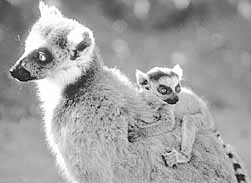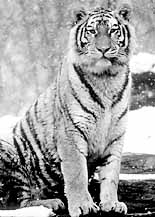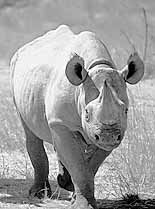![]()
![]()
![]()
![]()
![]()
![]()
![]()
A new report shows mounting evidence of jeopardy to world's animal species.
provided by World Conservation Union
![]() quarter of all known mammal species are at risk of
extinction, according to the new 1996 IUCN (World Conservation Union ) Red
List of Threatened Animals, the most comprehensive scientific assessment
of threatened species ever produced.
quarter of all known mammal species are at risk of
extinction, according to the new 1996 IUCN (World Conservation Union ) Red
List of Threatened Animals, the most comprehensive scientific assessment
of threatened species ever produced.
"The Red List is actually a red flag, warning
us about the imperiled status of animals and drawing attention to threats,
such as habitat destruction, pollution, over-harvesting and introduction
of foreign species," explained George Rabb, Chair of the Species Survival
Commission (SSC), the IUCN commission responsible for the creation of the
Red List.
The finding that 25 percent of mammal species
are threatened with extinction must drastically increase the urgency of
conservation initiatives across the globe. Until this assessment, the conservation
world has used the status of birds to estimate the level of threat to all
animals, because birds were the only group of species that had been fully
assessed. Eleven percent of all known bird species are threatened with extinction.
Estimates of other assessed species threatened with extinction are: 20 percent
of reptiles, 25 percent of amphibians, and 34 percent of fish, mostly freshwater
species.
More than 100 species of marine fishes were added
to the 1996 Red List, including sharks, tuna, coral reef
 fish
and sea horses. While the status of the remaining 14,000 marine species
has yet to be assessed, the recent additions indicate that many marine species
could be at higher risk than previously thought. All species of sturgeons
and paddlefish were found to be threatened or near threatened. Many freshwater
species from other groups of animals are also classified as threatened because
land use changes, pollution and channel modification have led to the deterioration
of freshwater habitats worldwide. "Wherever one looks, more freshwater
species turn out to be threatened than anyone ever suspected," said
Brian Groombridge, coeditor of the 1996 Red List and Coordinator of the
World Conservation Monitoring Centre's (WCMC) Animals Program.
fish
and sea horses. While the status of the remaining 14,000 marine species
has yet to be assessed, the recent additions indicate that many marine species
could be at higher risk than previously thought. All species of sturgeons
and paddlefish were found to be threatened or near threatened. Many freshwater
species from other groups of animals are also classified as threatened because
land use changes, pollution and channel modification have led to the deterioration
of freshwater habitats worldwide. "Wherever one looks, more freshwater
species turn out to be threatened than anyone ever suspected," said
Brian Groombridge, coeditor of the 1996 Red List and Coordinator of the
World Conservation Monitoring Centre's (WCMC) Animals Program.
U.S. Secretary of the Interior Bruce Babbitt noted,
"this report is probably the most thorough scientific assessment of
the state of the world's wildlife ever undertaken. It clearly indicates
that unless people of all nations make extraordinary efforts, we face a
looming natural catastrophe of almost biblical proportions.... Our children
and grandchildren should not be deprived of a world where these magnificent
and diverse wild animals can still find places to exist and raise their
young. Today's report is a clarion call to take action while we still can."
Created under the auspices of IUCN - The World
Conservation Union, the Red List contains 5,205 species assessments conducted
by more than 500 scientists worldwide. The product of the extensive SSC
network of scientists working in field stations, universities, and governments
around the world, the Red List is the most accurate and authoritative source
for the current status of animal populations.
More rigorous criteria were used to assess the
conservation status of species for the 1996 Red List than in previous editions.
The new Red List provides alternative approaches to assessing threat, such
as population decline, fragmentation of populations or low population numbers.
Different scientific approaches were used to assess levels of endangerment,
including rate of population decline over a ten-year period. Using this
criterion, critically endangered species are defined as those experiencing
an 80 percent decline; endangered, 50 percent; and vulnerable, 20 percent
decline.

Of the 26 orders of mammals, 24 include
threatened species, and the six largest orders have more than 50 threatened
species each. The highest proportion of threatened species are in the orders
that include monkeys and apes, 46 percent; shrews and moles, 36 percent;
pigs, antelope and cattle, 33 percent; bats, 26 percent; wild dogs, bears
and cats, 26 percent; and rodents, 17 percent. Other, smaller orders are
also highly threatened, including the order with horses, tapirs and rhinos,
with 22 percent critically endangered.
Of the 27 orders of birds, 23 contain threatened
species. The five orders with the highest percent of threatened species
are those that include rails and cranes, 26 percent; pheasants, and partridges,
25 percent; parrots, 25 percent; pigeons and doves, 17 percent; and kingfishers
and bee-eaters, 12 percent. China, Brazil and India appear in the top five
countries with the largest numbers of threatened birds and mammals.
Among reptiles, of the 23 species of crocodilians
(crocodiles, alligators, caimans), 44 percent are threatened. While this
figure is high, crocodilians are one of the few orders that have improved
in status due to conservation measures. In 1971, all 23 species of crocodilians
were endangered. Today, seven species are abundant enough to allow sustainable
use for the skins trade, and five species have stable or increasing populations.
While most animal species are invertebrates, the
Red List points out that very few have been assessed relative to their total
numbers. Those that have received the most attention are crustaceans, insects
and molluscs, with more threatened mollusks included in the Red List than
any other invertebrate group. Out of 70,000 documented mollusk species,
some 2,049 species were assessed, of which 920 were identified as threatened.
Approximately 30 percent (77 species) of all 250
known European freshwater fishes are classified as threatened. Fourteen
of those species are in the highest risk category, critically endangered.
This high proportion is indicative of widespread changes in the freshwater
systems of Europe. River and lake species are at great risk because of extremely
narrow habitat requirements. For example, the freshwater pearl mussel, harvested
for its white treasure, was once common throughout Europe. Due to excessive
harvesting, water pollution and modification of water courses, this mussel
is now endangered.
The most significant threat to the majority of
species at risk of extinction was found to be habitat reduction, fragmentation
and degradation, reflecting human population growth combined with economic
development. A surprisingly important factor was introduction of non-native
species, along with exploitation, pollution and climate change.

SSC partners, in particular WCMC, BirdLife International
and The Nature Conservancy, were major contributors to the 1996 IUCN Red
List. BirdLife International was responsible for determining bird categories.
The 1996 Red List marks three decades of international
efforts for the conservation of the world's biodiversity. The SSC is one
of six commissions within the IUCN. The SSC works to conserve biological
diversity with programs to study, save, restore and manage wisely species
and their habitats. The SSC volunteer network includes more than 7,000 scientists,
field researchers, government officials and conservation leaders from 179
countries.
Through science, economic development and community
involvement, Conservation International works to conserve global biological
diversity in ecological hot spots - those areas of the world with the highest
numbers of species at greatest risk. CI has projects in more than 20 countries
on four continents.
![]()
The 1996 IUCN Red List is available on the
World Wide Web at iucn.org/info_and_news/about_iucn/red-list.htm
The mission of IUCN is to influence, encourage and assist societies throughout the world to conserve the integrity and diversity of nature and to ensure that any use of natural resources is equitable and ecologically sustainable. Founded in 1948, The World Conservation Union brings together States, government agencies and a diverse range of non-governmental Organizations in a unique world partnership. A total of 133 countries are represented in this membership. World Headquarters: Rue Mauverney 28, CH-1196 Gland, Switzerland. E-mail: mail
![]() hq.iucn.org.
hq.iucn.org.